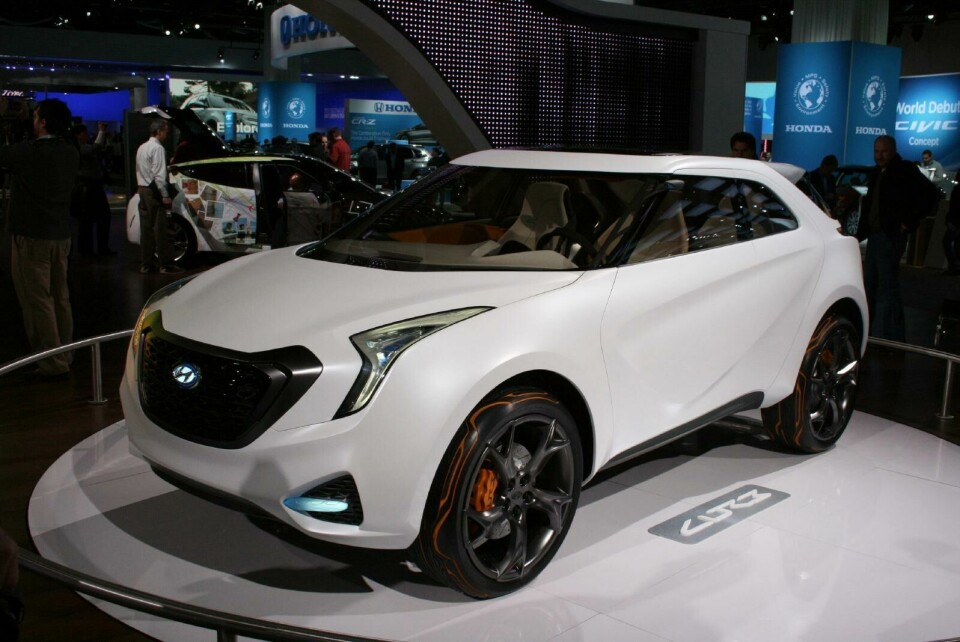
Design Review: Hyundai Curb concept
The Hyundai Curb (internal codename: HCD-12) is the twelfth concept designed at the company’s California Design Center











The Hyundai Curb (internal codename: HCD-12) is the twelfth concept designed at the company’s California Design Center.
The Curb clearly demonstrates Hyundai’s ambition to hop aboard the good ship Compact Crossover and share deck space with the Nissan Juke, Range Rover Evoque et al. as its product portfolio spreads. The Veloster coupe - also an NAIAS debutant - is a similar testament to this.






It takes on - and helps establish - some of the conventions already set in this most infant of sectors: increased ride-height, pronounced fenders, a shallow, tapered DLO and a rather cartoonish DRG. It also throws its own ingredient into the crossover mix in the shape of a three-box-aping side profile via the colorway between its C-pillar and wraparound rear glazing, despite its resolutely two-box silhouette.
This sedan-like aesthetic lends the Curb a distinctly different flavor to its fellow mashups in side profile; more elegant and less utilitarian in concept if not necessarily execution. It’s also a nod to the dominant C-pillars used on much lager SUVs such as the Land Rover Discovery (LR4) and Ford Explorer. However, the point at which the roof, C-pillar and upper luggage module meet is poorly resolved, detracting from what could be a neat feature.
In a similar fashion to the delightful Peugeot HR-1 concept and Nissan Juke, the Curb also borrows iconography from the mainstream B/C-segment hatchback genre, specifically in its head- and taillamp graphics. Where SUVs traditionally contain their lights within the boundaries of their DRGs, cars such as the Ford Focus and Peugeot 207 sport lamps that creep along the edges of their hoods and tailgates, forming the corners of the car. It’s a visual trick to disguise the heft brought about by increased hood heights and front overhangs due to pedestrian impact regulations and so lends itself perfectly to the hefty lower bodies of these crossbreeds.
On the subject of visual weight control, the Curb is the follower of that most prolific of auto design fashions: the embossed bodyside graphic. In this case it takes the form of a looping graphic that follows the header-rail, along the window tops and trailing edge of the rear door, before circumnavigating the door surfaces, turning back on itself to describe the waistline and reappearing to define the rear corner of the fender. It’s largely successful and certainly adds distinction to its flanks.
Yet at the same time it remains as disingenuous as the multiple surface changes on the Ford C-Max or the stamped ‘haunch’ above a Citroen DS4’s rear wheel. It must also pose a surfacing nightmare to digital modelers - could its matte white paint have been chosen to mask the confusion? Certainly the haste with which it appeared to have been applied would suggest a last-minute decision. This color choice also adds far too much emphasis to the rather porcine grille, itself a variation on the boomerang graphic that crops up in countless places around the car.
This clumsiness is also evident in the feature lines that flow from either side of the headlamps in an awkward whimper at the base of the A-pillar, which detracts from the very nicely resolved shutline graphics in the same area. Likewise, the squared-off plan shape of the scuttle adds nothing - except perhaps the perception of a shorter hood - yet contorts the base of the windscreen into a horribly twisted compound concave surface as the glazing is forced into unnatural forms.
Inside, the interior takes much from the i-Flow concept, in particular its IP, which employs a similar flow of display screens and control surfaces across its width. Unlike the i-Flow, which was a fully-working prototype, the Curb is little more than a mock-up from its IP to its wholly unconvincing ‘smart materials’ represented by crude embroidery. It does, however feature some neat design solutions, such as the continuous element that forms the front seat bases and dashboard structure. Its asymmetric color and trim design is also worthy of note for being well resolved if not particularly original.
Overall the Curb gives the impression its raison d’être is simply to inform of the company’s intentions to enter a certain market segment. On closer analysis its flamboyant styling hides rather simplistic design - not bad in itself, but when combined with a confused and rushed level of execution it falls some way short of the sort of thoroughness we’ve come to expect from Hyundai’s concept cars of late. And with sister company Kia ploughing such a neat furrow in the next field, it’s also a missed opportunity to reclaim some corporate ground.
Related Articles:
Design Review: Peugeot HR1 concept 
Design Development: Nissan Juke 



